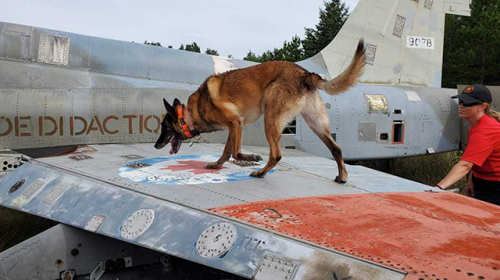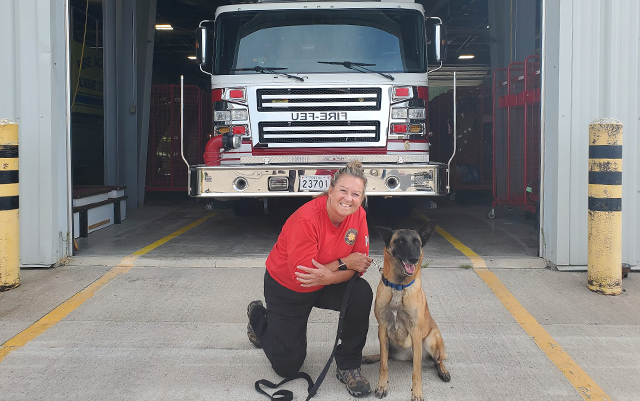On a beautiful Sunday in September, several members of the Georgian Bay Volunteer Search and Rescue came out to the Canadian Forces Fire and CBRN Academy (CFFCA) training area to hone their skills and to prepare two of their canine members for their upcoming certifications. They took advantage of our expansive area of 159 acres and maneuvered through challenging scenarios, making use of some of the training props in our “Disaster Village”.
Georgian Bay Search and Rescue began in 1998 and they currently have approximately 35 searchers. The team provides police and other agencies with professional volunteers in the form of highly trained and equipped search and rescue personnel who are available 24/7. Susan Read, Provincial K9 Coordinator, Central Regional Representative, ran the drills for the day. She is in her 21st year with the team. She is the owner of Zena and Zappa, the two dogs who were put through their paces that Sunday.
In Ontario, you must be on an Ontario Search and Rescue Volunteer Association (OSARVA) team to work a K9. Currently there are only four civilian K9 units in the province.
Zena is a 5-year-old female Malinois. She’s been certified with the Ontario Provincial Police (OPP) since 2019 as Live Find K9. She has three disciplines that she must pass: tracking (nose to ground following human odour), air scent for a person (nose to the wind) and air scent for articles or clues along with obedience and agility. Zena must certify annually.

Zena’s exercise consisted of finding a live human hidden in the training area. Impressively, she was able to locate a cell phone with the subject’s scent on it.
Zappa is a 9-year-old male Malinois. He has been certified as a Human Remains Detection K9 with North American Police Work Dog Association (NAPWDA) since 2015. He must pass in six areas to certify: rubble, building, vehicle, open area, water, and buried. He must also certify annually.
For Zappa’s exercise a small jar of tissue, replicating a cadaver, was placed in an air intake of an abandoned CF-5 aircraft. Another source was placed in a wing of an abandoned aircraft. He promptly located the sources and passed his exercise with flying colours.
Upon completion of the canine exercises, the human members of the team practiced their skills. The members of Georgian Base Search and Rescue perform these valuable duties on their own time and are not compensated financially for their efforts. They are truly among the unsung heroes that help keep our society safe.
By: CWO Donald Matthews, CD, CFFCA






